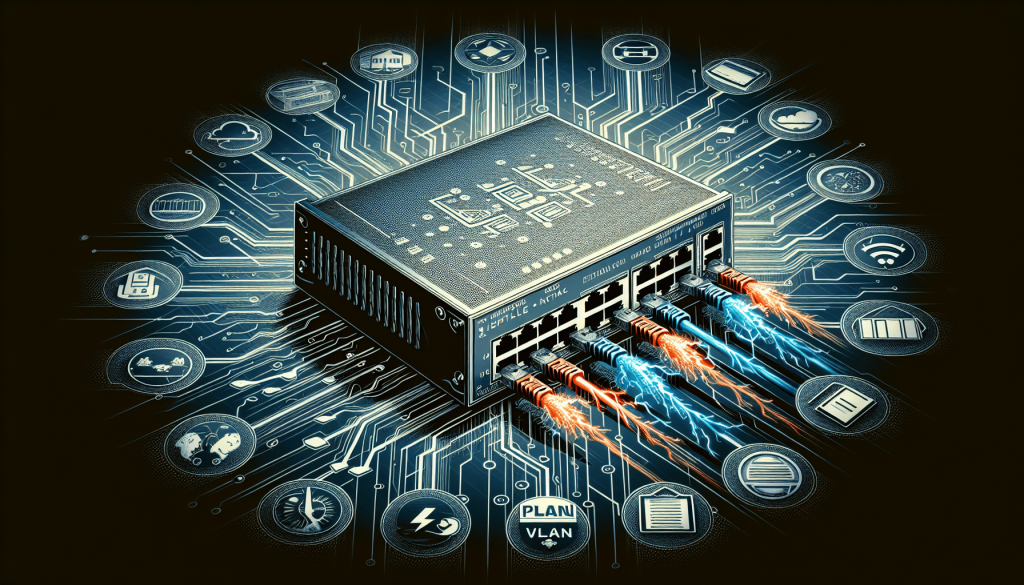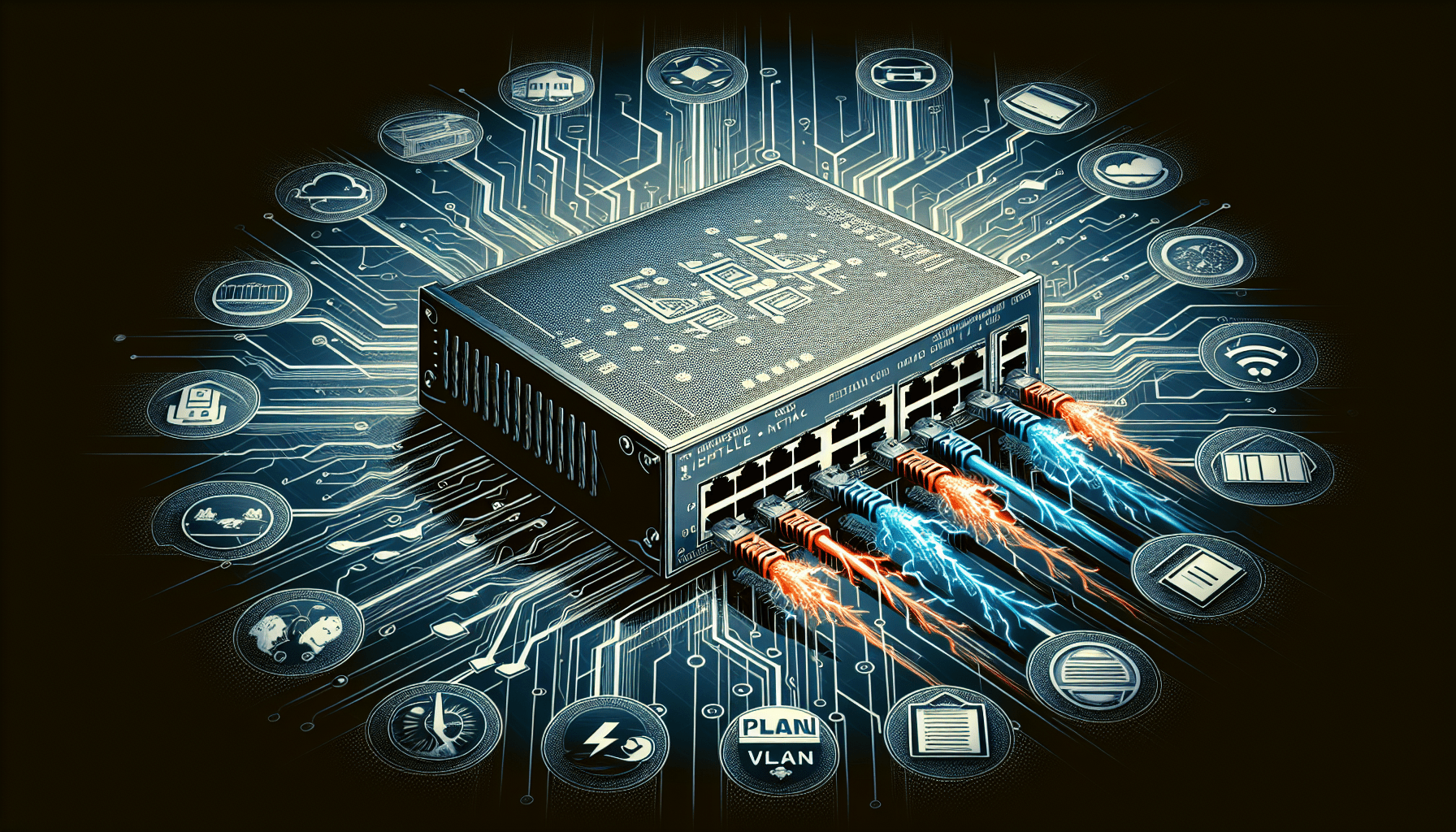When it comes to choosing a network switch, there are several important features that you should consider to ensure that it meets your specific needs. These key features include the number of ports available, the switch’s performance capabilities, its power over Ethernet (PoE) support, and its scalability. By thoroughly evaluating these features, you can make an informed decision that will enhance the efficiency and productivity of your network.

1. Port Capacity
When choosing a network switch, one of the key considerations is the number of Ethernet ports it offers. Ethernet ports are essential for connecting devices to the network, so having an adequate number of ports is crucial. The more ports a switch has, the more devices you can connect simultaneously. This is particularly important in environments with a high volume of network-connected devices, such as large offices or data centers.
In addition to the number of ports, it’s also essential to consider the speed of the Ethernet ports. The speed of the ports determines how quickly data can be transmitted between devices connected to the switch. Generally, network switches offer a range of port speeds, including 10/100 Mbps (megabits per second), 1 Gbps (gigabit per second), and even higher speeds like 10 Gbps or 40 Gbps. Choosing a switch with higher port speeds can ensure faster data transfers and improve overall network performance.
2. Power Over Ethernet (PoE) Support
Power over Ethernet (PoE) is a technology that allows network switches to deliver both power and data over the same Ethernet cable. It eliminates the need for separate power cables, making it easier to deploy network devices such as IP phones, wireless access points, and security cameras.
When considering PoE support, it’s important to look at the PoE standards supported by the switch. The two most common PoE standards are PoE (802.3af) and PoE+ (802.3at). PoE offers a maximum power output of 15.4 watts per port, while PoE+ can provide up to 30 watts per port. Depending on the power requirements of your network devices, choosing a switch with the appropriate PoE standard is essential.
Another factor to consider is the PoE power budget of the switch. The power budget refers to the total amount of power the switch can provide to its PoE-enabled ports. It’s important to ensure that the switch’s power budget is sufficient to meet the power requirements of all the PoE devices connected to it. If the power budget is not adequate, some devices may not receive enough power, which can lead to performance issues or devices not functioning properly.
3. Layer Support
Layer support refers to the different layers of the OSI (Open Systems Interconnection) model that a network switch can operate at. Each layer of the OSI model represents a different level of network functionality.
Layer 2 switching refers to the ability of a switch to forward data packets at the data link layer (MAC address level) of the OSI model. It enables switches to create separate collision domains and efficiently forward data within the local network.
Layer 3 switching, on the other hand, operates at the network layer (IP address level) and allows switches to perform routing functions. This means they can make intelligent routing decisions based on IP addresses, improving network performance and reducing the load on routers.
Layer 4 switching adds an additional layer of intelligence by considering transport layer protocols (such as TCP and UDP) in the forwarding decision-making process. This allows switches to optimize traffic flow and improve network performance.
When choosing a network switch, it’s important to assess your network requirements to determine the appropriate layer support needed. For simple networks, layer 2 switching may be sufficient, but for more complex environments or those requiring advanced routing capabilities, layer 3 or layer 4 switching may be necessary.
4. Network Speed
Network speed is a crucial factor in determining how quickly data can be transferred between devices connected to the switch. It directly impacts the overall performance and efficiency of the network.
Throughput refers to the amount of data that can be transmitted through a network switch within a given period. It is typically measured in bits per second (bps) or megabits per second (Mbps). Higher throughput values indicate that the switch can handle a larger volume of data, resulting in faster data transfers.
Forwarding rate, on the other hand, measures the speed at which a switch can process and forward data packets. It is quantified in packets per second (pps). A higher forwarding rate indicates that the switch can handle a larger number of data packets simultaneously, resulting in improved network performance.
When considering network speed, it’s crucial to ensure that the switch’s throughput and forwarding rate align with the requirements of your network. High-speed switches are beneficial in environments with heavy network traffic or when dealing with bandwidth-intensive applications such as video streaming or large file transfers.

5. VLAN Support
Virtual Local Area Networks (VLANs) allow for the segmentation of a physical network into logical networks, bringing several benefits such as enhanced security, improved performance, and simplified network management.
The number of VLANs supported by a network switch is an essential factor to consider. It determines how many separate logical networks can be created on the switch, each with its own unique set of network configurations and access controls. Having a higher number of VLANs supported provides flexibility in network design and enables efficient management of network resources.
VLAN trunking is another significant consideration. Trunking enables the transmission of multiple VLANs over a single physical connection. This allows for the efficient use of network infrastructure and simplifies the configuration and management of VLANs. It’s important to choose a switch that supports VLAN trunking protocols such as IEEE 802.1Q to facilitate the seamless transmission of VLAN traffic.
6. Management Options
Efficient management of a network switch is crucial for network administrators to monitor and control the network effectively.
Web-based management provides a user-friendly interface accessible through a web browser, allowing administrators to easily configure and manage the switch’s settings. It provides a graphical representation of the network topology and simplifies the monitoring of network performance and statistics.
CLI (Command Line Interface) management offers a more advanced and granular level of control over the switch’s configuration. It allows administrators to execute commands directly on the switch, ideal for experienced network professionals who prefer a command-driven interface.
SNMP (Simple Network Management Protocol) support is another vital management option to consider. SNMP allows network administrators to monitor and manage network devices from a centralized network management system. It facilitates the collection of performance data, configuration management, and network troubleshooting.
When selecting a network switch, it’s important to consider the management options that best suit the skillset and preferences of the network administrators, ensuring efficient and convenient management of the network.
7. Redundancy and Resilience
In a network environment, ensuring high availability and minimizing downtime is critical. Redundancy and resilience features in a network switch contribute to maintaining a stable and reliable network infrastructure.
Spanning Tree Protocol (STP) is a crucial redundancy feature that prevents network loops by selectively blocking redundant links. STP detects and disables any redundant paths, ensuring a loop-free network topology and preventing broadcast storms. Consider a switch that supports advanced variants of STP, such as Rapid Spanning Tree Protocol (RSTP) or Multiple Spanning Tree Protocol (MSTP), as these provide faster network convergence and enhanced loop prevention.
Link Aggregation, also known as port trunking or bonding, combines multiple physical ports into a single logical link. This improves network performance, load balancing, and redundancy. Switches that support link aggregation protocols such as IEEE 802.3ad (LACP) allow for the creation of fault-tolerant connections to other switches or network devices.
Having a redundant power supply option is essential for ensuring uninterrupted operation. Switches with redundant power supply capabilities can automatically switch to a backup power source if the main power supply fails. This guarantees that the network switch remains operational, minimizing downtime and preventing disruptions.
When evaluating network switches, it’s important to consider these redundancy and resilience features to build a robust and reliable network infrastructure.
8. Security Features
Security is a paramount concern in network environments, and network switches play a crucial role in implementing robust security measures.
Access control features in a network switch allow administrators to enforce strict access policies and limit network access to authorized devices only. These features include MAC address filtering, which allows or denies network access based on MAC addresses, preventing unauthorized devices from connecting to the network.
Port security features enable administrators to control network access at the port level. This includes features like port-level authentication, which requires users to enter credentials before accessing the network, ensuring only authorized users can connect.
VLAN isolation adds an extra layer of security by separating traffic between different VLANs, preventing unauthorized access or data leakage between VLANs. It provides isolation and segmentation, enhancing network security and minimizing the impact of potential security breaches.
When selecting a network switch, it’s vital to consider these security features to protect your network from unauthorized access, data breaches, and potential security threats.
9. Quality of Service (QoS)
Quality of Service (QoS) is a crucial feature for prioritizing and managing network traffic, ensuring that critical applications and services receive the necessary bandwidth and network resources.
Traffic prioritization in a network switch allows administrators to assign different levels of priority to different types of network traffic. This ensures that time-sensitive applications, such as voice and video streaming, receive priority over less critical traffic. Proper traffic prioritization helps prevent latency and ensures a smooth and uninterrupted user experience.
Bandwidth control features enable administrators to allocate and limit the available bandwidth to specific devices, applications, or VLANs. This ensures that bandwidth-intensive applications do not monopolize network resources, leading to fair resource allocation and optimized network performance.
Choosing a network switch with comprehensive QoS capabilities is essential for maintaining optimal network performance and ensuring that critical applications receive the necessary resources to function efficiently.
10. Scalability
Scalability is an important consideration when selecting a network switch, especially in growing network environments.
Stackability refers to the ability to combine multiple switches into a single logical unit or stack. This allows for simplified management and configuration of multiple switches, reducing administrative overhead and providing a unified view of the network.
The number of switches that can be included in a stack is an important factor to consider when evaluating the scalability of a network switch. The ability to add more switches to a stack provides flexibility and ensures that the network can expand seamlessly as the requirements grow.
When choosing a network switch, it’s important to consider the scalability options offered, ensuring that the switch can accommodate future growth and expansion without compromising network performance or manageability.
In conclusion, when selecting a network switch, it’s essential to consider various important features to ensure that the switch aligns with your network requirements. From port capacity and network speed to security features and scalability options, each feature plays a significant role in building a robust, efficient, and secure network infrastructure. By carefully evaluating these features and their alignment with your network needs, you can make an informed decision when choosing the right network switch for your organization.
